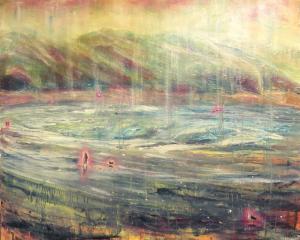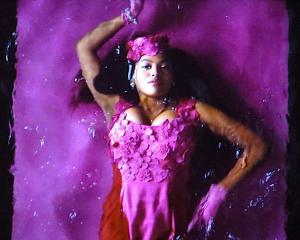"Momento", Jan Ingram and Leila Ataya (Artist's Room, B Gallery)
A joint exhibition by Leila Ataya and Jan Ingram currently graces the walls of The Artist's Room.
Ingram's work typically features collections of mementoes against backlit frosted windows.
Her ability to realistically portray the suffused light's interplay with the glass makes her paintings special, and this display does not disappoint.
The soft symbolism of Send Me A Light and the attention to detail and precise brushwork of Weaving Time show a subtle progression, while at the same time continuing the artist's trademark themes.
Ataya's work shows a change of direction, however.
While her larger pieces still show pearls, lace, and mechanical insects against a luscious velvet dark, a new element has crept in, that of miniature furry animals.
The effect is partially successful, but while these add a previously missing warm humour, they detract from the precise purity of the works and take them from magic realism into the realms of whimsy.
They work best when most of the still-life elements are removed so that the focus is entirely on the animals, as in The Catterfly.
The anthropomorphic creatures are used to greater advantage in a series of the artist's miniatures also on display.
With their oval vignettes placed within a painted black and gold frame, these works are pure delightful whimsy.
Milford Galleries Dunedin, is taking a break from its traditional solo exhibitions with a group show focusing on small works by several of its better-known artists.
The show is a good opportunity to see how well some of these artists' work translates to the smaller format, since several of the artists are usually seen primarily with large works.
With several of the artists the transition is very favourable.
Reuben Paterson's work, in particular, is very strong when reduced to simple monochromatic geometric forms in the artist's trademark glitter.
Peata Larkin's tukutuku-inspired abstract pointillism is also effective in this size.
The small format is less complimentary to Karl Maughan's garden scenes, which appear overbearing and claustrophobic at this size.
Peter James Smith's works, though still attractive, also lose something through the lack of epic sweep.
Garry Currin and Callum Arnold's paintings might also be expected to suffer for this reason, but here the impressions of landforms retain their compelling depth and focus.
Paul Mason's softly hued glass crucibles provide a welcome break from the canvases which surround the room.
Light is caught and held by these elegant vessels as if it were liquid, the cups becoming imbued with a soft warm glow.
The anonymous collective ffffff has created a connected series of installations at the Blue Oyster dealing with the unease of the mysterious space and the tension of exploring novel terrain.
Three rooms, each occupied by a single artwork speaking of location and dislocation, are organised so the visitor to the gallery becomes an active participant in the environment.
The first room contains a mound built from triangles cut from old vinyl records, behind which is projected a cloudy sky.
The hillside formed, with the implied sanctuary beneath it, resembles the geometric frameworks used in three-dimensional computer art, a virtual space which one may walk around while being simultaneously bombarded by a jarring thrum emanating from speakers beneath the structure.
Small confined hollows dominate the second room, and the gallery visitor is invited to enter the darkened interiors of these wedge-shaped containers.
The outside is shut off by the muffling walls of the forms, forcing entrants to look within themselves.
In the final installation, soil from closed schools and children's homes has been ceremoniously placed on the floor, and the visitor walks across this while examining photographs of the soil's sources.
The room thus becomes a psycho-geographic map of lost institutions and perhaps of lost childhood itself.






![... we all become all of these things [installation view] (2025), by Megan Brady.](https://www.odt.co.nz/sites/default/files/styles/odt_landscape_small_related_stories/public/story/2025/03/1_we_all_become_all_of_thes.jpg?itok=SH-Q8KJZ)


![Poipoia te Kākano [installation view]. Allison Beck, Megan Brady, Kate Stevens West, Jess...](https://www.odt.co.nz/sites/default/files/styles/odt_landscape_small_related_stories/public/story/2025/02/1_poipoia_te_k_kano.jpg?itok=_BEDlada)


